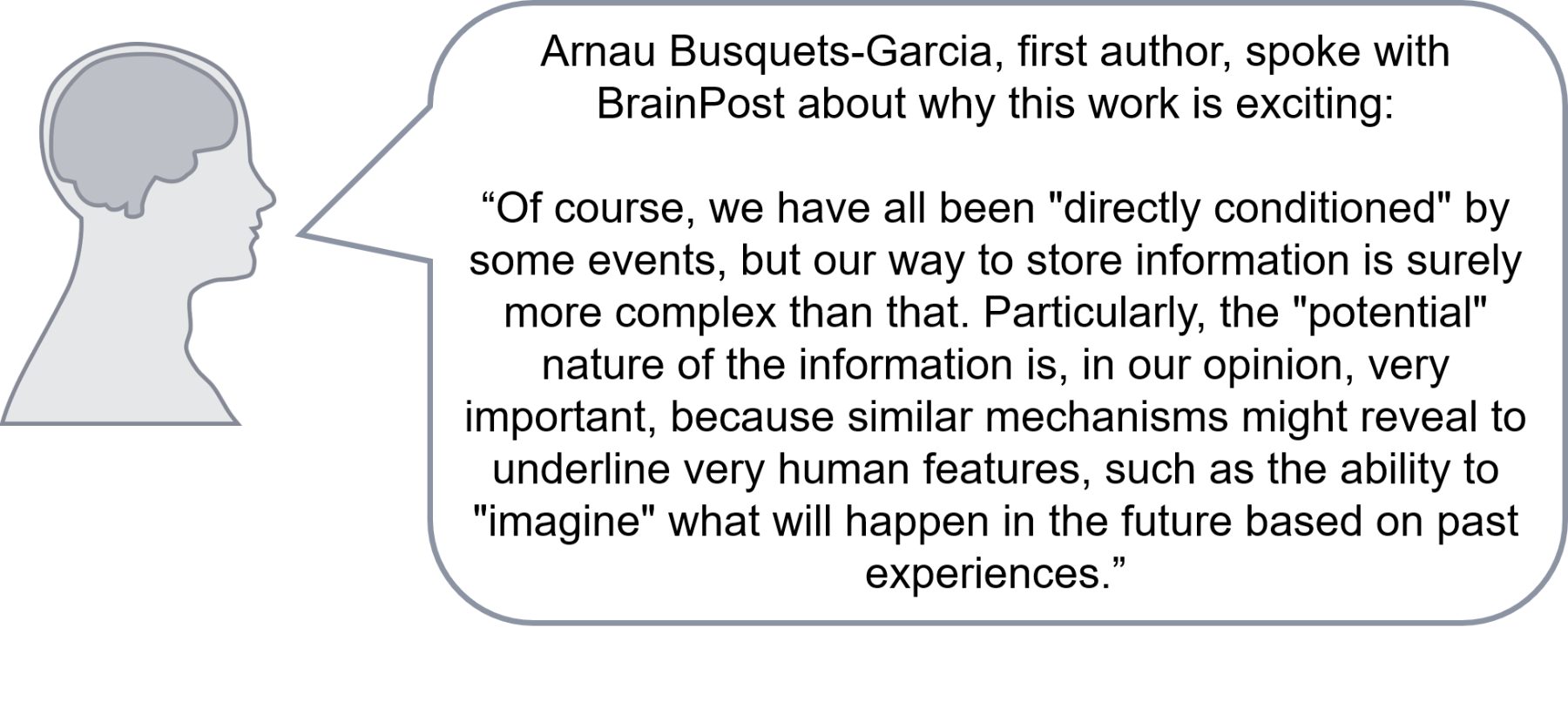Mediated Learning is Dependent on Type 1 Cannabinoid Receptors
Post by Sarah Hill
What's the science?
CB1 receptors bind cannabinoids (a class of chemical compounds) produced within the body (endocannabinoids) and are known to be involved in learning and memory. Binding of CB1R to cannabinoids originating outside of the body, for example during consumption of marijuana, can cause cognitive impairment. In contrast, endocannabinoid binding to CB1R within the hippocampus is involved in direct associative learning (a simple form of learning where an association is made between a certain stimulus and an outcome, such as the pairing of a sound with a subsequent food reward). Whether CB1R and the endocannabinoid system in general are involved in other higher-order forms of learning, such as ‘mediated learning’, is not known. Mediated learning is when a stimulus is paired with an outcome indirectly through association with another stimulus (also known as an incidental association). This week in Neuron, Busquets-Garcia and colleagues demonstrate that hippocampal CB1Rs are specifically required for mediated learning.
How did they do it?
The authors carried out a sensory preconditioning task in mice with a number of transgenic and pharmacological interventions. The sensory preconditioning procedure consisted of three phases: 1) Two low-salience stimuli (such as odor and taste) were presented to male mice simultaneously to promote formation of an incidental association between the two (pre-conditioning phase) 2) One of the original stimuli was directly paired with either an aversive or a reward reinforcer (conditioning phase), increasing the salience of the outcome-associated stimulus and indirectly pairing the other stimulus with the same outcome 3) Mice were presented with either the directly-paired or the indirectly-paired stimuli in order to evaluate direct associative learning or mediated learning respectively (test phase). In the first variation of sensory preconditioning, the authors paired odor and taste with an aversive outcome (gastric malaise). To ensure that their results were not restricted to odor and taste stimuli, nor to an aversive outcome, the authors carried out an additional sensory preconditioning task by pairing two new stimuli, a light and a sound, with a food pellet reward outcome.
As a basic test of CB1R activity in mediated learning, sensory preconditioning was first carried out using mice who had CB1R deleted or 'knocked-out' on a brain-wide level. Next, to determine the timeframe of CB1R activity during mediated learning, the authors administered a CB1R antagonist (i.e. blocker) at different time points throughout the task, either before the preconditioning phase or the test phase. To assess which brain region CB1R-dependent mediated learning occurs within, they repeated the experimental procedure after deleting CB1R within the hippocampus. Finally, to identify the neurons involved in CB1R-dependent mediated learning, the authors carried out the sensory preconditioning task in mice lacking CB1R specifically in forebrain GABAergic inhibitory interneurons. Because CB1R helps to suppress GABAergic inhibitory neurotransmission, the authors hypothesized that CB1R inhibition of GABA neuron firing may be critical for incidental associations and mediated learning to occur. To test this, they infused a viral vector expressing inhibitory designer receptors exclusively activated by designer drugs (DREADD) to either inhibit or excite GABAergic neurons in the hippocampi of mice lacking CBR1 before preconditioning. This allowed them to observe the impact of activating or inhibiting GABAergic neurons on mediated learning.
What did they find?
Wild-type (control) mice that underwent sensory preconditioning consumed reduced amounts of tastes or odors that were indirectly or directly paired with gastric malaise, suggesting that mediated and associative (direct) aversion learning had occurred. Likewise, increased reward-seeking behavior was observed in response to stimuli when two associated stimuli were directly- and indirectly-paired with a reward outcome. However, the results did not hold for indirect-pairing of a stimulus-outcome duo when CB1R knock-out mice or CB1R antagonist-dosed mice underwent sensory preconditioning (direct-pairing was unaffected). This suggests that CB1 receptors are required for higher-order/mediated learning to occur. Administration of a CBR1 antagonist (blocker) at different timepoints revealed that CB1Rs are specifically activated during the formation of incidental associations, but not during expression of mediated aversive or reward-seeking behaviors. Additional transgenic and viral approaches further confirmed that CB1 receptors involved in this mode of learning are uniquely expressed by GABAergic interneurons within the hippocampus.
Suppression of hippocampal GABAergic signaling (accomplished using inhibitory DREADDs) in mice lacking CBR1 in the hippocampus, was sufficient to recover mediated learning deficits (normally observed in animals lacking CB1R inhibitory function). Conversely, excitatory DREADDs used to activate inhibitory GABAergic transmission, effectively overriding suppression by CB1R, resulted in reduced consumption of the indirectly-paired taste stimulus but not the directly-paired stimulus. Taken together, these findings indicate that excess inhibitory signaling during preconditioning disrupts the formation of incidental associations, blocking mediated learning. Therefore, CB1R are necessary to regulate the activity of GABAergic interneurons. The authors performed a follow-up experiment to show that the GABAergic neurons involved are not parvalbumin positive interneurons (approximately half of GABAergic neurons in the hippocampus). This suggests that the remaining half, presumably interneurons containing cholecystokinin (CCK), are the neuronal subpopulation responsible for driving mediated learning.
What's the impact?
This study identified a unique role for Type 1 cannabinoid receptors in a form of higher-order learning called mediated learning. Specifically, CB1R expressed by non-parvalbumin GABAergic interneurons within the hippocampus contribute to this learning process and are activated during formation of incidental associations. As CB1R has been implicated in a number of psychiatric and neurological disorders, this is an important finding to consider when designing CB1R-targeting therapeutic strategies.
Busquets-Garcia et al., Hippocampal CB1 Receptors Control Incidental Associations. Neuron (2018). Access the original scientific publication here.


